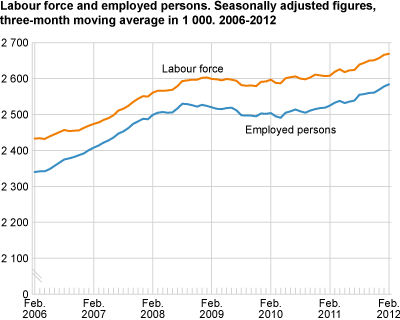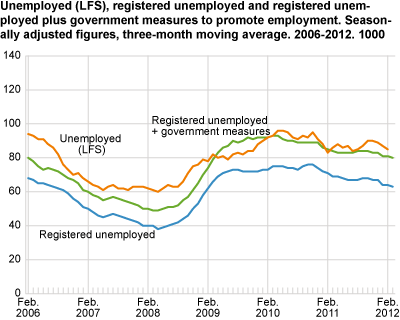Content
Published:
This is an archived release.
Increased share of men in the workforce
From the 1st quarter of 2011 to the 1st quarter of 2012, the labour force participation among men rose by 1.2 percentage points. In this year’s first quarter, the share of men aged 15-74 participating in the labour force was 74.5 per cent. The corresponding share for women was 68.3 per cent, almost unchanged from the previous year.
From the 1st quarter of 2011 to the same quarter of 2012, the number of men in the workforce rose by 46 000, and the number of women by 14 000. The population growth of women was, however, stronger than the growth of labour force participants, while it was the other way around for men. The development of the labour force participation rate therefore differed between men and women. The labour force participation rate for the entire population was 71.4 per cent in the 1st quarter of 2012, up 0.5 percentage points from the same quarter of 2011.
Employment up by 59 000 since last year
During the period from the 1st quarter of 2011 to the 1st quarter of 2012, the number of employed persons in Norway increased by 59 000. The strongest growth took place among those aged 24 years or less. In this group, the growth was mainly in the form of an increase in part-time working. The majority of the part-time employed persons under 25 years are also studying. From the 1st quarter of 2011 to the same quarter of 2012, there was an increase of 29 000 persons working full-time. The main part of this increase was among men, while the increase in people working part-time related to both men and women.
Seasonally-adjusted figures also show increased employment in the short termAdjusted for seasonal variations, the number of employed persons increased by 23 000 from the 4th quarter of 2011 to the 1st quarter of 2012. The unemployment rate was 3.2 per cent of the labour force in the 1st quarter of 2012, down 0.2 percentage points from the 4th quarter of 2011. The decrease is within the LFS margin of error. Adjustments for seasonal variations allow for the analysis of underlying developments in the labour market. Seasonally-adjusted figures are presented in a separate article . The rest of the figures in this article are not seasonally adjusted. |
Stable unemployment
In the 1st quarter this year, the 86 000 unemployed corresponded to 3.2 per cent of the labour force - the same as in the 1st quarter of 2011. Twenty-nine per cent of the unemployed were long-term unemployed - down 5 percentage points compared with the same quarter last year. Long-term unemployed are persons who have been unemployed for more than 26 weeks.
45 000 underemployed women
Underemployed are part-time employed who have tried to find more work. In the 1st quarter of 2012, there were 61 000 underemployed - whereof 45 000 were women. As a proportion of all part-time employed people, the share of underemployed decreased from 10 per cent in the 1st quarter of 2011 to 9 per cent in the 1st quarter of 2012.
The time the 61 000 underemployed wanted to work extra in the 1st quarter of 2012 corresponded to 20 000 full-time jobs. Adding the time that the unemployed wanted to work that quarter, the work wanted by these two groups corresponded to 95 000 full-time jobs.
|
The labour force is the sum of employed and unemployed persons between 15-74 years of age. From the 1st quarter of 2011 to the 1st quarter of 2012, the LFS shows that employment rose by 59 000 persons and unemployment rose by 2 000 persons. This gives an increase in the labour force of 61 000 persons. In the same period, the population also increased by 61 000 persons, so the labour force participation rate increased somewhat. Coherence between the conceptsUnemployed + Employed = Labour force Labour force + Outside the labour force = Population |
Tables:
- Table 1. Population aged 15-74, by labour force status(LFS) and sex 1 000
- Table 2. Population aged 15-74, by labour force status (LFS) and sex. Changes from the same period inthe previous year. 1 000
- Table 3. Population aged 15-74 by labour force status(LFS) and sex. Per cent
- Table 4. Persons in the labour force and employed persons aged 15-74, by age and sex (LFS). 1000
- Table 5. Persons in the labour force and employed persons aged 15-74, by age and sex (LFS). In per cent of the population
- Table 6. Persons aged 15-74, employed persons by contractual/usual working hours per week and unemployedpersons by age and sex (LFS). 1000
- Table 7. Persons in the labour force aged 15-74 by age and sex (LFS). 1000
- Table 8. Persons in the labour force aged 15-74 by age and sex (LFS). As per cent of all in each group
- Table 9. Employed persons aged 15-74 by sex and contractual/usual working hours per week (LFS). 1 000
- Table 10. Population aged 15-74, by main activity, part-time employment and age (LFS). 1 000
- Table 11. Employed persons aged 15-74 by major industry division (LFS). 1 000
- Table 12. Average number of man-weeks worked (37,5 hours), by industry division (LFS). 1 000
- Table 13. Employed persons aged 15-74 and average number of man-weeks worked (a 37.5 hours)by sex and status. 1000. Actual working hours, by sex and status. Hours perweek.
- Table 14. Employed persons aged 15-74 and absence from work during the whole reference weekby reason for absence and sex (LFS). 1 000
- Table 15. Employed persons aged 15-74 and absence from work during the whole reference weekby reason for absence and sex (LFS). Per Cent
- Table 16. Employees aged 15-74 with temporary jobs, by major industry division (LFS). 1000
- Table 17. Employees aged 15-74 with temporary jobs, by major industry division (LFS).In per cent of all employees
- Table 18. Unemployed persons aged 15-74 by sex and age (LFS). 1000 andper cent
- Table 19. Unemployed persons aged 15-74 by duration of job search (LFS).1 000 and per cent
- Table 20. Unemployed persons aged 15-74, by main activity (LFS). 1 000
- Table 21. Unemployed and underemployed persons aged 15-74, by sex and desired working hours per week.Number of man-weeks (of 37,5 hours) supplied
- Table 22. Employed persons aged 15-74, by sex and region of residence(LFS) 1 000
- Table 23. Employed persons aged 15-74, by sex and region of residence (LFS) as per cent of all inn each group
Contact
-
Arbeidsmarked og lønn
E-mail: arbeidsmarked@ssb.no
-
Erik Herstad Horgen
E-mail: erik.horgen@ssb.no
tel.: (+47) 93 08 68 62
-
Håvard Hungnes Lien
E-mail: havard.lien@ssb.no
tel.: (+47) 40 90 26 06


